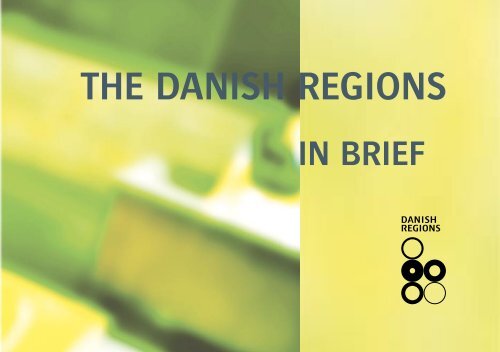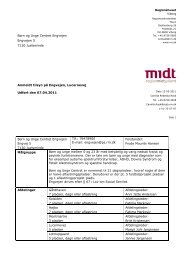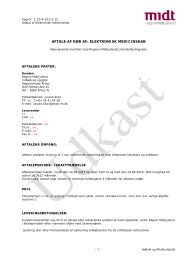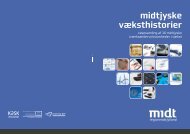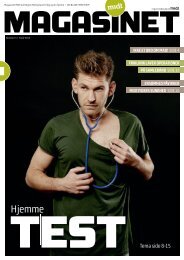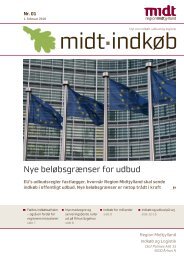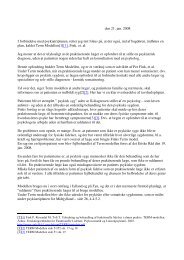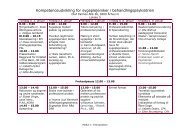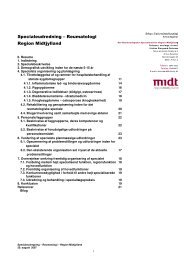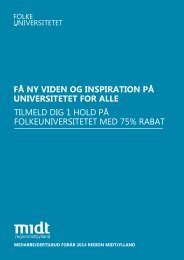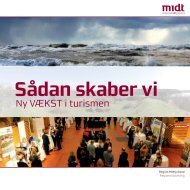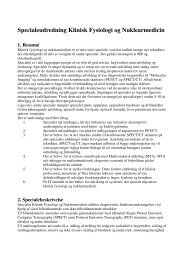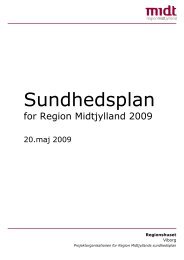THE DANISH REGIONS
THE DANISH REGIONS
THE DANISH REGIONS
You also want an ePaper? Increase the reach of your titles
YUMPU automatically turns print PDFs into web optimized ePapers that Google loves.
<strong>THE</strong> <strong>DANISH</strong> <strong>REGIONS</strong><br />
IN BRIEF
CONTENTS<br />
PREFACE<br />
Regional Councils .................................................................................. 5<br />
Regions .................................................................................................. 7<br />
Tasks and Finances ................................................................................. 11<br />
• Health ............................................................................................... 13<br />
• Mental Health ................................................................................... 18<br />
• Social Services and Special Education .................................................. 19<br />
• Regional Development ...................................................................... 20<br />
• Soil Pollution ..................................................................................... 23<br />
• Public Transport ................................................................................. 25<br />
Contact the Regions .............................................................................. 27
PREFACE<br />
On 1 January 2007, the five new regions are established: The Capital Region<br />
of Denmark, The Sealand Region, Region of Southern Denmark, Central<br />
Denmark Region, and North Denmark Region.<br />
With this leaflet ”The Danish Regions – in Brief”, Danish Regions wishes to<br />
provide an overview of the tasks and finances of the five regions.
REGIONAL COUNCILS<br />
The governing bodies of the regions are the regional councils with 41 members directly elected for four years periods.<br />
The head of the regional council is the regional council chairman who is elected by the regional council.<br />
The first regional election was held on 15 November 2005. The Social Democratic Party became the largest party<br />
with 77 members, and 60 members were elected from the Liberal-Democratic Party. Three of the regional council<br />
chairmen are Social Democrats, and two are Liberal Democrats.<br />
The regional council election on 15 November 2005<br />
Region A B C F K O V Ø L<br />
Poll in Women Regional<br />
per<br />
Council<br />
cent<br />
Chairman<br />
Capital Region 13 5 6 3 0 3 8 3 0 65.6 18 (44%) A<br />
of Denmark<br />
Sealand Region 14 2 3 3 0 4 13 1 1 70.4 11 (27%) V<br />
Region of<br />
14 1 6 2 0 3 13 1 1 71.4 14 (34%) V<br />
Southern Denmark<br />
Central Denmark 6 2 3 2 1 2 14 1 0 72.2 14 (34%) A<br />
Region<br />
North Denmark<br />
Region<br />
20 1 2 2 1 2 12 0 1 69.0 12 (29%) A<br />
Total 77 11 20 12 2 14 60 6 3 69.4 69 (34%) -<br />
A. The Danish Social Democratic Party. B. The Danish Social-Liberal Party. C. The Conservative Party. F. The Socialist People’s Party K. The Christian<br />
Democratic Party. O. The Danish People’s Party. V. Venstre. Denmark’s Liberal Democratic Party. Ø. The Danish Red-Green Alliance. L. Local lists<br />
Source: Statement made by Danish Regions<br />
5
<strong>REGIONS</strong><br />
The new regions include the following areas:<br />
The Capital Region of Denmark: The former counties of Copenhagen and Frederiksborg,<br />
the Regional Municipality of Bornholm, the City of Copenhagen, and the City of Frederiksberg.<br />
The Sealand Region: The former Counties of Roskilde, West Sealand, and Storstrøm.<br />
Region of Southern Denmark: The former Counties of Ribe, South Jutland and Funen,<br />
and the southern part of the County of Vejle (9 municipalities).<br />
Central Denmark Region: The former Counties of Ringkjøbing and Aarhus and the<br />
northern part of the County of Vejle (7 municipalities), the southern part of the County<br />
of Viborg (12 municipalities).<br />
North Denmark Region: The former County of North Jutland, the northern part of the<br />
County of Viborg (5 municipalities) and the municipality of Mariager from the County<br />
of Aarhus.<br />
7
Viborg<br />
Central Denmark<br />
Region<br />
North Denmark<br />
Region<br />
Vejle<br />
Aalborg<br />
The population of the new regions ranges from approx.<br />
580,000 in the North Denmark Region to approx.<br />
1,630,000 in The Capital Region of Denmark.<br />
In terms of surface area, The Capital Region of Denmark<br />
is the smallest covering 2,561 square kilometres<br />
and the Central Denmark Region the largest covering<br />
13,142 square kilometres.<br />
Hillerød<br />
The Capital Region of<br />
Denmark<br />
Region of Southern<br />
Denmark<br />
Sorø<br />
The Sealand Region<br />
8
Area and population, January 2006<br />
Region Population Area sq. km. Population<br />
per sq. km.<br />
The Capital Region<br />
of Denmark<br />
1.634.000 2.561 638<br />
The Sealand Region 812.000 7.273 112<br />
Region of Southern<br />
Denmark<br />
1.186.000 12.191 97<br />
Central Denmark Region 1.220.000 13.142 93<br />
North Denmark Region 577.000 7.931 73<br />
Entire Country 5.429.000 43.098 126<br />
Source: Statistics Denmark, The Danish Ministry of the Interior and Health, and information from the individual regions<br />
Note: The figures indicating area are preliminary and subject to change based on boundary adjustments<br />
Age distribution in per cent, January 2006<br />
Region 0-14 years 15-19 years 20-64 years 65+ years<br />
The Capital Region<br />
of Denmark<br />
18 5 62 15<br />
The Sealand Region 19 6 59 16<br />
Region of Southern<br />
Denmark<br />
19 6 59 16<br />
Central Denmark Region 20 6 60 14<br />
North Denmark Region 18 6 59 16<br />
Entire Country 19 6 60 15<br />
Source: Statistics Denmark<br />
9
Expected relative population increase 2004-2020<br />
4.0%<br />
3.0%<br />
2.0%<br />
1.0%<br />
0.0%<br />
-1.0%<br />
Capital Region Sealand Southern Denmark Central Denmark North Denmark Entire Country<br />
-2.0%<br />
Source: Central Denmark Region<br />
Note: Significant differences in the expected population growth in the individual regions may occur<br />
10
TASKS AND FINANCES<br />
The tasks of the regions include health care, operation of social<br />
and special education institutions, and regional development.<br />
In 2007, the regions’ operational expenditure will amount to<br />
approx. DKK 80 billion of which municipal co-financing constitutes<br />
approx. DKK 18 billion. The figures do not include<br />
turnover within social services and special education as this<br />
expenditure is fully financed through rate income from the<br />
municipalities. Turnover will amount to approx. DKK 4 billion.<br />
The regions will have just above 110,000 full time employees.<br />
The regions will be financed through contributions from the<br />
state and the municipalities, including rate payments. The<br />
economy is divided into three “boxes” – health, social services<br />
and special education, and regional development. The three<br />
areas will be financed separately and should each balance.<br />
11
Regional Tasks<br />
Regional Financing<br />
Health<br />
• Somatic hospital service<br />
• Health insurance<br />
• Mental health treatment<br />
Social services and special education<br />
• Operation of institutions for exposed<br />
groups<br />
Regional development<br />
• Business promotion<br />
• Tourism<br />
• Nature and environment<br />
• Employment<br />
• Education and culture<br />
• Development in remote areas and in<br />
rural districts<br />
• Soil pollution, raw material mapping<br />
and planning<br />
• Public transport<br />
Health<br />
• Block grants<br />
• State activity-related subsidy<br />
• Local basic contribution<br />
• Local activity-related contribution<br />
Social services and special education<br />
• Rate financing and objective financing<br />
Regional development<br />
• Block grants<br />
• Local development contribution<br />
12
Health<br />
The regions will be responsible for the entire hospital service, including mental health treatment and health insurance.<br />
Total operational expenditure will amount to approx. DKK 76 billion in 2007.<br />
Expenditure within the health care sector is approx. 9 per cent of the GNP (2003). Since 2000, this share has increased<br />
slightly, but it is unchanged compared to 1980. During the same period, expenditure has increased in all comparable<br />
countries and in some countries quite significantly.<br />
Public and private health expenditure in per cent of the GNP in selected countries<br />
Country 1980 1990 2000 2001 2002 2003<br />
USA 8.7 11.9 13.1 13.9 14.6 15.0<br />
Germany 8.8 8.7 10.6 10.7 10.9 11.1<br />
Norway 7.0 7.8 7.7 8.3 9.9 10.3<br />
France … 8.6 9.3 9.5 9.7 10.1<br />
The Nederlands 7.5 8.0 8.6 8.9 9.3 9.8<br />
Sweden 9.1 8.5 8.4 8.7 9.2 ,,,<br />
Belgium 6.4 7.4 8.7 9.0 9.1 9.6<br />
Denmark 9.1 8.5 8.3 8.6 8.8 9.0<br />
New Zealand 5.9 6.9 8.0 8.2 8.2 8.1<br />
Great Britain 5.6 6.0 7.3 7.6 7.7 ,,,<br />
Finland 6.4 7.9 6.7 7.0 7.2 7.4<br />
Source: Counties in Figures and OECD DATA 2005<br />
Note: Figures in italics are estimates<br />
13
Annual activity at somatic hospital wards comprises approx. 1 million discharges, approx. 5.1 million bed days, and<br />
approx. 7.4 million outpatient visits. Average duration of hospitalisation is 4.9 days.<br />
Key figures, somatic hospital treatment 2004 by region<br />
Region<br />
Discharges<br />
(1,000)<br />
Bed days<br />
(1,000)<br />
Average duration<br />
of hospitalisation<br />
(days)<br />
Outpatient<br />
visits<br />
(1,000)<br />
The Capital Region<br />
of Denmark 337 1,754 5.2 2,556<br />
The Sealand Region 141 691 4.9 997<br />
Region of<br />
Southern Denmark 227 1,067 4.7 1,728<br />
Central Denmark<br />
4.6 1,534<br />
Region 234 1,085<br />
North Denmark<br />
Region 96 503 5.2 616<br />
Total 1,035 5,100 4.9 7,431<br />
Source: The Danish Patient Register 2004<br />
Note: Computed by region of treatment<br />
14
The regions’ tasks within the health care sector are financed through four kinds of subsidies: A block grant from<br />
the state, a state activity-related subsidy, a local basic contribution, and a local activity-related contribution.<br />
The state block grant constitutes 75 per cent of the financing. The allocation is based on objective distribution criteria.<br />
The state activity-related subsidy constitutes op to five per cent of the financing.<br />
The local basic contribution constitutes approx. 10 per cent of the financing. In 2007 it will amount to DKK 1,100<br />
per inhabitant.<br />
The local activity-related contribution, which is approx. 10 per cent of the financing, will depend on how much the<br />
citizens use the health care service.<br />
Financing of the regions’ health care expenditure<br />
10%<br />
5%<br />
10%<br />
State block grant<br />
State activity-related<br />
contribution<br />
Local basic contribution<br />
Local activity-related<br />
contribution<br />
75%<br />
15
Regarding health insurance, the regions enter into agreements with general practitioners, dentists, etc. on the<br />
type of services that they will subsidise. Consequently, the regions will pay for medical care and subsidise dental<br />
care, medicine, etc.<br />
The largest service groups are general practitioners - approx. 3,400, dentists - approx. 2,600, and physiotherapists<br />
- approx. 1,700.<br />
Number of general practitioners, health insurance 2004<br />
Service groups<br />
Inhabitants<br />
per professional<br />
General practitioners 3,436 1,580<br />
Specialists 1,148 4,710<br />
Dentists 2,566 2,110<br />
Physiotherapists 1,707 3,170<br />
Chiropractors 262 20,650<br />
Chiropodists 1,011 5,350<br />
Psychologists 545 9,930<br />
Source: Danish Regions<br />
Note: The figures regarding physiotherapists are from 2003<br />
16
General practitioners have approx. 6.3 consultations annually per inhabitant, ranging from 5.8 in The Capital Region<br />
of Denmark to 6.7 in the South Denmark Region.<br />
Consultations with general practitioners per inhabitant in 2003 by region<br />
8<br />
6<br />
4<br />
2<br />
0<br />
8<br />
6<br />
4<br />
2<br />
Capital Region Sealand Southern Denmark Central Denmark North Denmark Entire Country<br />
Source: The Sealand Region<br />
In connection with the Local Government Reform, the municipalities will take over tasks involving rehabilitation<br />
and prevention. In order to support co-operation with the municipalities, health co-ordination committees will be<br />
established to ensure correlation of the regional and the local activities regarding rehabilitation, prevention, and<br />
care. In addition, health care agreements, including agreements on the discharge process for the weak and elderly<br />
patients and agreements on prevention and rehabilitation, will be made.<br />
17
Mental Health<br />
The regions are responsible for mental health treatment.<br />
Mental health treatment includes stationary and outpatient treatment at psychiatric hospitals, centres, and wards.<br />
It also includes district psychiatry, investigative psychosis teams, and other travelling teams. In addition, the regions<br />
should provide consulting services to regional and local institutions.<br />
There is an annual activity of approx. 40,000 discharges, approx. 1.2 million bed days and approx. 800,000 outpatient<br />
visits. The average duration of hospitalisation is 28.7 days.<br />
Key figures for mental health treatment in 2004 by region<br />
Region<br />
Discharges<br />
(1,000)<br />
Bed days<br />
(1,000)<br />
Avarage duration<br />
of hospitalisation<br />
(days)<br />
Outpatient<br />
visits<br />
(1,000)<br />
Capital Region<br />
of Denmark 15 561 36.4 365<br />
Sealand Region 6 156 26.7 105<br />
Region of<br />
Southern Denmark 9 205 22.8 173<br />
Central Denmark<br />
Region 10 206 21.2 160<br />
North Denmark<br />
Region 2 84 37.5 37<br />
Total 42 1,212 28.7 840<br />
Source: The Danish Patient Register 2004<br />
Note: Computed by region of treatment<br />
18
Social Services and Special Education<br />
From 2007, the municipalities will have full authority and financing responsibility for those tasks within social services<br />
and special education that have previously been undertaken by the counties.<br />
The regions will have a statutory obligation to the municipalities to provide a number of social services and to<br />
continue and develop the previous county services that the municipalities for professional or financial reasons do<br />
not wish to perform.<br />
The individual regions and the municipalities in the region will enter into annual framework agreements that<br />
define the municipalities’ use of the regional services.<br />
The regions’ expenditure will mainly be covered by the municipalities through cost-based rates. Financing of<br />
special education nationally and regionally will, however, consist of a basic contribution from all the municipalities<br />
determined by objective criteria.<br />
In 2007, the regions will be responsible for 255 institutions with a total of 6,096 places. This corresponds to approx.<br />
20 per cent of the current number of institutions in the counties.<br />
Social services and special education institutions in the regions in 2007<br />
Institutions Institutions Places<br />
Day centres, adults 55 1,636<br />
Housing, adults 113 3,196<br />
24-hour care centres for children and young people 44 709<br />
Reception centres 10 283<br />
Communication centres 15 -<br />
Special education 8 191<br />
Other 10 81<br />
Total 255 6,096<br />
Source: Statement made by Danish Regions<br />
19
Regional Development<br />
The regions should ensure that goals are set for regional development. The regions should also prepare regional<br />
development plans and they will be responsible for establishing regional growth fora.<br />
The regional development plan should present a vision for the development of the region, including cities, rural<br />
districts and remote areas as well as nature and environment, business and trade, tourism, employment, education,<br />
and culture.<br />
Each regional council and the Regional Municipality of Bornholm have established a regional growth forum. The<br />
growth fora have representatives from trade and business, educational institutions, labour and management, and<br />
politicians from the region and the municipalities.<br />
The growth fora’s responsibility is to monitor regional and local conditions for growth. A regional business development<br />
strategy should be prepared which will be part of the basis for the development plan of the regional<br />
council. The regional councils will provide a secretarial function for the regional growth fora.<br />
Furthermore, the regional growth fora will be responsible for prioritising use of EU’s Structural Funds, i.e. the<br />
European Social and Regional Funds. The funds amount to approx. DKK 400 million a year which will be spent on<br />
strengthening regional competitiveness, growth, and employment.<br />
Regional business development activities may include: Innovation, use of new technology, establishment and development<br />
of new companies, development of human resources, tourism and development in remote areas.<br />
In addition, the regions will undertake coordination of youth education and implementation of regional cultural<br />
events.<br />
20
The regions’ expenditure for regional development tasks, including public transport and soil pollution, will<br />
amount to approx. DKK 2 billion in 2007. The expenditure will be financed through a state block grant and a local<br />
development contribution which will amount to DKK 110 per inhabitant in 2007.<br />
The expenditure will be distributed as follows: Approx. 50 per cent for public transport, approx. 15 per cent for<br />
activities required in connection with soil pollution and 35 per cent for other regional development activities.<br />
Distribution of regional development expenditure<br />
35%<br />
Public transport<br />
Soil pollution<br />
Other expenditure<br />
50%<br />
15%<br />
21
Unemployment by region, 2004<br />
Business growth by region, 2004<br />
9.0%<br />
8.0%<br />
7.0%<br />
6.0%<br />
5.0%<br />
4.0%<br />
3.0%<br />
2.0%<br />
46.0%<br />
44.0%<br />
42.0%<br />
40.0%<br />
38.0%<br />
36.0%<br />
1.0%<br />
0.0%<br />
Capital Region Sealand South Denmark Central Denmark North Denmark Entire Country<br />
34.0%<br />
Capital Region Sealand South Denmark Central Denmark North Denmark Entire Country<br />
Source: Central Denmark Region<br />
Source: Central Denmark Region<br />
Note: The diagram illustrates the amount of workplaces in the region within industries<br />
which nation-wide had a growth rate of at least 10 per cent in the period from<br />
1993 to 2003.<br />
Employed persons by profession and region, 2004<br />
Educational profile for employed persons by region, 2004<br />
100%<br />
100%<br />
80%<br />
Public services<br />
80%<br />
60%<br />
40%<br />
20%<br />
Trade and services<br />
Construction<br />
Production<br />
Primary businesses<br />
60%<br />
40%<br />
20%<br />
Further education<br />
Vocational education<br />
Non-vocational education<br />
Source: Central Denmark Region<br />
22<br />
0%<br />
Capital Sealand South Central<br />
Region<br />
Denmark Denmark<br />
North<br />
Denmark<br />
Entire<br />
Country<br />
0%<br />
Capital Sealand South Central<br />
Region<br />
Denmark Denmark<br />
Source: Central Denmark Region<br />
North Entire<br />
Denmark Country
Soil Pollution<br />
The regions are responsible for activities in relation to soil pollution. These<br />
activities include:<br />
• Mapping and investigation.<br />
• Monitoring.<br />
• Prioritisation and implementation of the public cleaning-up operations<br />
on polluted land.<br />
• Processing cases within the loss of value scheme and the OM scheme<br />
(Environmental Funds of the Oil Business).<br />
The regions’ operational expenditure in 2007 concerning these activities will<br />
amount to approx. DKK 300 million.<br />
In terms of environment, the regions are also responsible for raw material<br />
mapping, and planning.<br />
23
Expected extent of cleaning-up operations<br />
Number of properties expected to be mapped as possibly polluted 55,000<br />
Expected number of preliminary and supplementary investigations 43,000<br />
Expected number of cleaning-up operations, groundwater, and problems 3,300<br />
with the indoor climate<br />
Expected number of cleaning-up operations, private properties 5,000<br />
Source: Material from Information Centre on Contaminated Sites<br />
Note: The table shows an estimate of the extent of total cleaning-up operations<br />
24
Public Transport<br />
Tasks in relation to local and regional public transport will be undertaken by the new transport companies to be<br />
established by the regions in co-operation with the municipalities. The regions will appoint two and the municipalities<br />
seven members to seat in the boards of the transport companies.<br />
The preliminary decisions regarding establishment of the transport<br />
companies indicate that there will be a total of six transport<br />
companies, one in the North Denmark Region, one in the Central<br />
Denmark Region, two in the Southern Denmark Region, one in<br />
The Sealand Region, and one in Bornholm. It is a statutory requirement<br />
that one combined company should be established in<br />
Sealand covering The Capital Region of Denmark and The Sealand<br />
Region.<br />
The transport companies will be responsible for regional bus<br />
services, pricing and ticketing systems, time schedules, handicap<br />
services, and private railways.<br />
The transport companies will be financed through rates and subsidies<br />
from the regions and the municipalities.<br />
The regions will finance regional bus services, private railways,<br />
and administration. The regions’ expenditure in 2007 for this<br />
purpose will amount to approx. DKK 1 billion based on the current<br />
task level in the counties.<br />
25
Public bus services and private railways in 2004<br />
Public bus services<br />
Contribution per inhabitant (DKK) 420<br />
Passenger share of financing (per cent) 58<br />
Scheduled travel per inhabitant 1.7<br />
Private railways<br />
Number of travels (million) 10.9<br />
Average length of travel (km) 18.4<br />
Source: Danish Regions<br />
26
Contact the Regions<br />
The Capital Region of Denmark<br />
Kongens Vænge 2<br />
DK-3400 Hillerød<br />
Mail: regionh@regionh.dk<br />
Internet: www.regionhovedstaden.dk<br />
Telephone: +45 4820 5000<br />
Central Denmark Region<br />
Tingvej 15<br />
DK-8800 Viborg<br />
Mail: kontakt@regionmidtjylland.dk<br />
Internet: www.regionmidtjylland.dk<br />
Telephone: +45 8728 5000<br />
Danish Regions<br />
Dampfærgevej 22<br />
DK-2100 Copenhagen<br />
Mail: regioner@regioner.dk<br />
Internet: www.regioner.dk<br />
Telephone: +45 3529 8100<br />
The Sealand Region<br />
Alleen 15<br />
DK-4180 Sorø<br />
Mail: regionsjaelland@regionsjaelland.dk<br />
Internet: www.regionsjaelland.dk<br />
Telephone: +45 7015 5000<br />
North Denmark Region<br />
Niels Bohrs Vej 30<br />
DK-9220 Aalborg<br />
Mail: regnord@ regnord.dk<br />
Internet: www.regionnordjylland.dk<br />
Telephone: +45 9635 1000<br />
Danish Regions, Brussels Office<br />
Rue de la Science, 4<br />
B-1000 Brussels<br />
Mail: arf@arf.be<br />
Telephone: + 32 2 550 1280<br />
Region of Southern Denmark<br />
Damhaven 12<br />
DK-7100 Vejle<br />
Mail: kontakt@regionsyddanmark.dk<br />
Internet: www.regionsyddanmark.dk<br />
Telephone: +45 7943 2100<br />
Note: For some of the regions, mail addresses and telephone numbers are preliminary.<br />
27
Dampfærgevej 22<br />
Box 2593<br />
DK-2100 Copenhagen<br />
Telephone +45 3529 8100<br />
E-mail: regioner@regioner.dk<br />
www.regioner.dk<br />
3rd revised edition, 2007<br />
Editors: Danish Regions<br />
Graphic design: Kristine Wulff, Danish Regions<br />
Printed by: Danish Regions<br />
ISBN: Printed edition 978-87-7723-471-2<br />
ISBN: Electronic edition 978-87-7723-472-9


